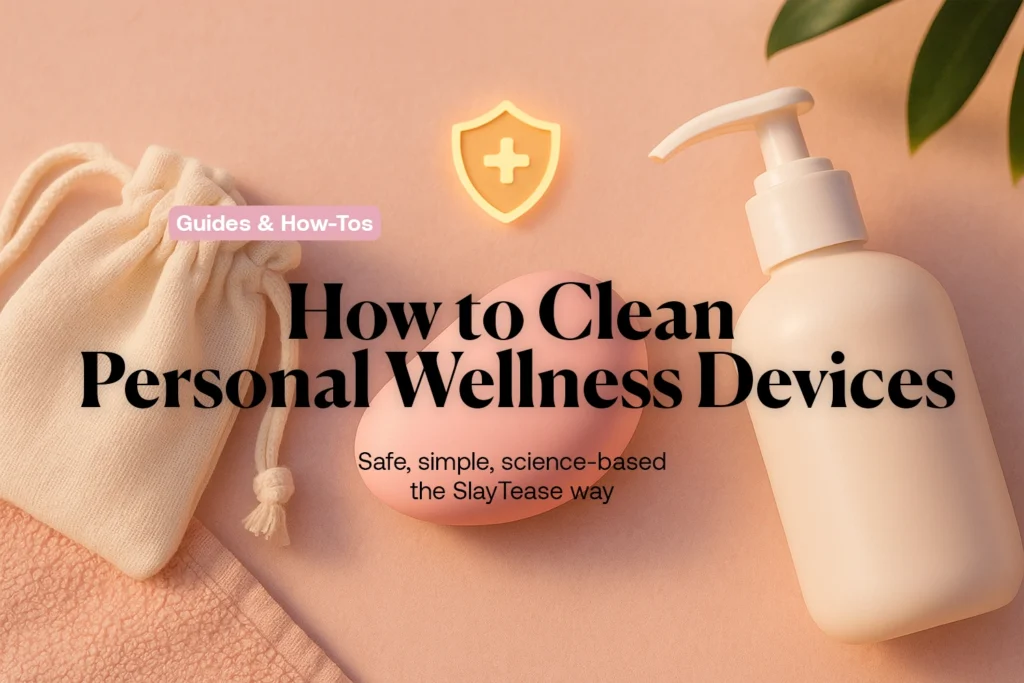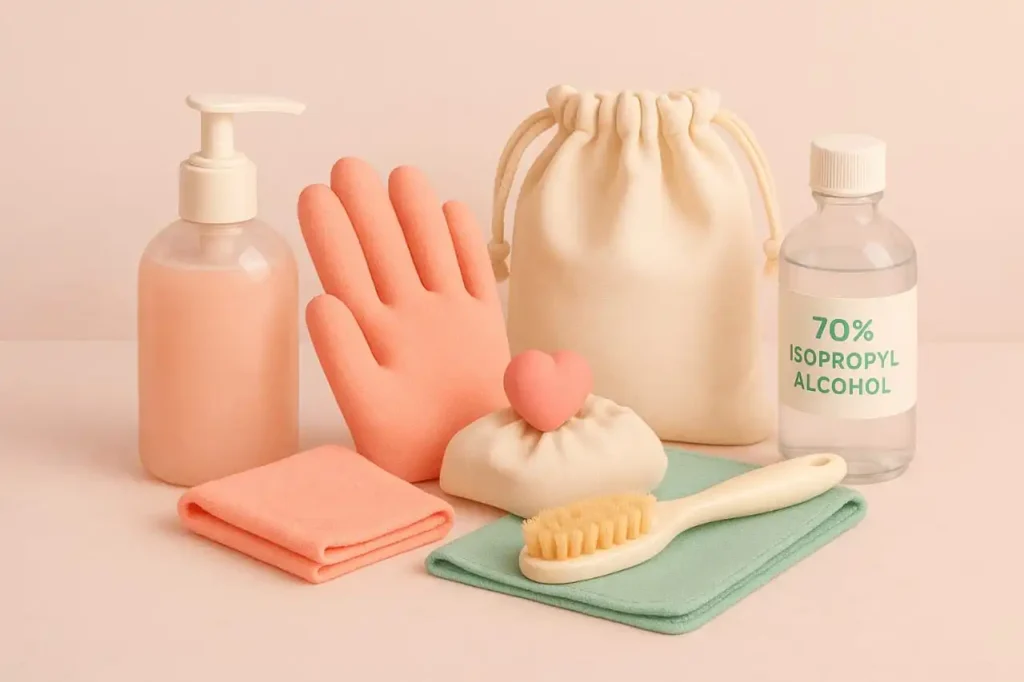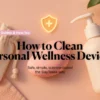( how to clean sex toys Safe, simple, science-based — the SlayTease way)

When you keep your personal wellness devices clean, they last longer, feel better, and keep your body safe. This guide gives you clear, material-specific steps for everyday cleaning and deeper disinfection — plus the big do’s and don’ts most people miss.
At a Glance: What “Clean” Actually Means
- Clean = remove visible residue (soap + water).
- Sanitize = reduce germs to safer levels (good everyday goal).
- Disinfect/Sterilize = kill most/all microbes (for non-porous, non-electronic items when needed: post-illness, sharing, anal-to-vaginal switch).
Golden rule: Non-porous materials (100% silicone, stainless steel, borosilicate glass, ABS) can be fully disinfected. Porous materials (TPE/TPR, elastomers, jelly rubber, some “silicone blends”) cannot be reliably sterilized — clean thoroughly and use barriers (condoms) if sharing.
Your Quick-Clean Kit

- Mild, unscented liquid soap (no moisturizers, no triclosan)
- Warm water
- Soft cloth or dedicated soft brush
- 70% isopropyl alcohol (for non-porous, non-electronic parts only)
- Optional: dedicated toy cleaner (nice to have, not required)
- Clean, breathable storage pouch (cotton/microfiber)
Universal Steps: Everyday Clean (Most Devices)
- Power off & unplug. Remove batteries/attachments where possible.
- Rinse the surface with warm water (skip rinsing if the item isn’t water-resistant).
- Wash with a pea-sized amount of mild, unscented soap. Use fingers/soft cloth to reach grooves.
- Mind the ports. Keep water away from charging jacks, seams, and buttons on non-waterproof items — use a damp cloth instead.
- Rinse thoroughly to remove soap residue.
- Air-dry completely (lint-free area).
- Store separately from other materials in a breathable pouch.
When to Disinfect (Not Every Time)
- After illness or if there’s blood/visible bodily fluids
- If sharing with a partner (or switching anal → vaginal use)
- Before first use or after long storage
- When the device accidentally contacts unclean surfaces
Safe Disinfect Options (Choose One — for Non-Porous, Non-Electronic Items)
- Boil 3 minutes (100% silicone, stainless steel, borosilicate glass).
- 10% unscented bleach solution (1 part household bleach : 9 parts water). Soak ≤10 minutes, rinse extremely well, and air-dry.
- 70% isopropyl alcohol wipe-down. Keep wet for 30 seconds+, then rinse and dry.
Never disinfect electronics in liquid. For motorized gear, use alcohol wipes or manufacturer-approved sprays on the surface only, then wipe with water-damp cloth and dry.
Material-by-Material: Exactly What to Do
1) 100% Silicone (Non-Electronic)
- Clean: Warm water + mild soap; rinse well.
- Disinfect: Boil 3 minutes or 10% bleach or 70% alcohol.
- Lube note: Use water-based lube (many silicone lubes can bond and cloud).
2) Silicone Vibrators / Motorized Devices
- Clean: Damp-cloth wash with mild soap. Avoid submersion unless rated IPX7+ waterproof.
- Disinfect: Surface with 70% alcohol wipe; avoid liquid ingress.
- Dry: Tip device so water runs away from ports.
3) Stainless Steel & Borosilicate Glass
- Clean: Soap + warm water; check for chips/micro-cracks (glass).
- Disinfect: Boil 3 minutes, 10% bleach, or 70% alcohol.
- Note: If cracked/chipped, retire it.
4) ABS Plastic, Hard Acrylic
- Clean: Soap + warm water.
- Disinfect: 70% alcohol wipe; avoid soaking.
- Avoid: Boiling/bleach—can stress plastics or cloud finishes.
5) TPE/TPR, “Jelly,” Elastomers (e.g., many masturbator sleeves)
- Clean: Rinse inside & out, soap wash, rinse until squeaky; air-dry fully.
- Finish: Light dusting of cornstarch (not talc) to maintain feel.
- Disinfect: Cannot fully sterilize. Do not use alcohol/bleach (can crack/weaken).
- Sharing: Use barriers (condoms) and consider non-porous alternatives long-term.
6) Pumps, Suction Devices & Air-Pulse Toys
- Clean: Detach removable heads/caps; wash those parts with soap + warm water.
- Body/Handle: Wipe with a damp cloth; keep water away from valves and motors.
- Disinfect: Only removable non-porous tips can be boiled/bleached; motor housing = wipe-only.
7) Pelvic-Floor Trainers, Kegel Weights, Menstrual Cups
- Clean: Soap + warm water before/after use.
- Disinfect (non-electronic, silicone or medical-grade materials): Boil 3 minutes between cycles or after illness.
- Strings/Cords: Rinse thoroughly; avoid fraying.
Drying & Storage (Where Most People Slip Up)
- Air-dry completely — moisture invites odor and microbes.
- Separate materials (don’t let silicone rest on TPE/TPR).
- Cool, dark, dry spot — avoid direct sun and extreme heat.
- Breathable pouch — cotton or microfiber; skip airtight plastic bags.
- Traveling? Pack a few alcohol wipes and a spare pouch; clean again after you get home.
Common Mistakes to Avoid
- Submerging non-waterproof electronics (even for “just a second”).
- Using harsh cleaners (acetone, ammonia, scented soaps, peroxide on porous materials).
- Dishwasher “hack.” Detergents + heat can damage finishes and gaskets; boiling is safer for non-electronic, non-porous items.
- Mixing bleach with anything except water (never with ammonia or acids).
- Storing while damp or touching other materials.
- Switching anal → vaginal without disinfecting or changing a barrier.
Quick Troubleshooting
- Lingering smell (non-porous): Wash → 70% alcohol wipe → rinse → air-dry in open air 24h.
- Cloudy silicone after silicone lube: Wash with mild soap repeatedly; switch to water-based lube going forward.
- Sticky TPE sleeve: Wash, dry fully, then dust with cornstarch.
- Black spots/mold (porous item): Discard and replace.
Safety & Sharing
- For partners or toy-sharing, use condoms/dental dams — especially on porous items or when switching body sites.
- Sensitive skin? Choose unscented soap, rinse longer, and patch-test on your forearm first.
- Irritation or recurrent infections? Pause use and consult a clinician.
FAQ
Yes. Mild, unscented soap + warm water is enough for daily cleaning.
Not every time. Disinfect after illness, before first use, if sharing, or when switching anal → vaginal.
Yes for 100% silicone without electronics, followed by a water rinse. Avoid alcohol on TPE/TPR and electronics.
~3 minutes at a gentle boil for non-electronic silicone, glass, or steel.
Some work well, but follow the device and material manufacturer’s guidance; don’t UV-treat porous elastomers.





[…] 💡 If you use toys in your content, check out our guide on How to Clean Sex Toys the Right Way. […]
[…] If toys appear in your content: keep it hygienic and safe—read this: How to Clean Sex Toys the Right Way […]
[…] If your content includes devices/props, keep everything clean and body-safe: How to Clean Sex Toys the Right Way […]
[…] Expect moderation for ToS breaches; plan SFW funnels on social platforms. (If you feature devices/props in BTS, keep everything hygienic: How to Clean Sex Toys the Right Way.) […]
[…] If your content features devices/props, keep everything hygienic and body-safe: How to Clean Sex Toys the Right Way […]
[…] How to Clean Sex Toys the Right Way […]
[…] 💡 Want to include devices/props? Stay hygienic: How to Clean Sex Toys the Right Way […]
[…] Watermark paid content; keep gear and props hygienic and body-safe (especially if toys appear in BTS or tutorials):➜ How to Clean Sex Toys the Right Way […]
[…] Safety first: if your content includes devices/props, keep everything clean and body-safe for you and viewers. See: How to Clean Sex Toys the Right Way […]